For three decades, Granary Books has brought together writers, artists, and bookmakers committed to exploring and expanding the relations among the verbal, visual, and other arts. Presenting a selection of UI Libraries’ comprehensive collection of Granary editions, this exhibition traces Granary publisher Steven Clay’s career from his beginnings as a UI undergraduate in the 1970s to his present position as one of the most significant small publishers in the country. Selected items include printed matter in a wide variety of formats, among them Western and accordion-fold codices, broadsides, and a wall-hung contemporary quipu. The artists represented include John Ashbery, Susan Bee, Charles Bernstein, Ted Berrigan, John Cage, Henrik Drescher, Emily McVarish, Carolee Schneemann, Buzz Spector, and Cecilia Vicuña.
“At Granary, books are not neutral containers but are invested with a life of their own, conceived as objects first and foremost, entering the world not as the discardable shell of some other story but piping their own tunes on their own instruments.” – Charles Bernstein (2001)
Charles Bernstein is only one of many prominent poets whose work lives in editions created by writers and visual artists collaborating with Granary Books publisher and proprietor Steven Clay. Since 1991, when Clay’s pairing of the composer, writer, performer, and theorist John Cage with artist Barbara Fahrner resulted in Nods, Granary Books has become one of North America’s most significant independent presses.
The University of Iowa is not only Clay’s alma mater, but also is home to a comprehensive collection of Granary’s books, which reside in the Main Library’s Special Collections. All Library visitors are welcome to proceed to the third-floor reading room, request a Granary edition, listen for the instrument’s “tune,” and play along.
Drawing its title from Clay’s description of Granary’s mission – “exploring the relationships between seeing and reading, reading and seeking” – this exhibition presents a selection of editions that demonstrate the book’s flexibility as a concept, as an object, and as an intellectual and sensory experience that occurs in time and space. The books vary widely, but each aims to engage readers in encounters that expand our sense of what reading is or can be.
Selected Items
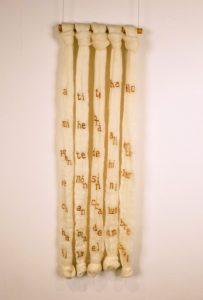 |
Vicuña, Cecilia. Chanccani Quipu. New York: Granary Books, 2012. Spanish and Quechua. English translation by the artist and Jerome Rothenberg. Unspun wool, knotted and stenciled by the artist, suspended from bamboo. With Instruction Manual and Orientation to Various Meanings, including a hand-colored drawing by the artist. Hand-stenciled box by Susan Mills. 32 copies. [in the catalog]
This exhibition commences with an artists’ book that urges visitors to ask themselves questions they might not have considered since childhood: what is a book? How do we use it? How do we receive the information it transmits between its makers and receivers? Chanccani Quipu reminds readers that there have been, and still are, many forms of writing in this hemisphere other than the alphabetic systems imported and imposed by European colonizers. The indigenous people of the Andes region used the quipu – a complex, multidimensional system of twisted and knotted cords – to record key information about their societies. The quipu is central to the Chilean-born Vicuña’s poetry, installations, films, and performances. Chanccani Quipu spans the gaps between media instituted by Western aesthetics: it is a poem, an installation, and a performance object that can be animated by those who view or speak the words “metaphorically” imprinted on the “river of fleece.” In the printed material, Vicuña and Rothenberg translate the Quechua chanccani as “begin now.” Vicuña writes that the book’s title “may be a command or a plea (depending on the tone of voice). It is a prayer for the rebirth of a way of writing with breath, a way of perceiving the body and the cosmos as a whole engaged in a continuous reciprocal exchange.” |
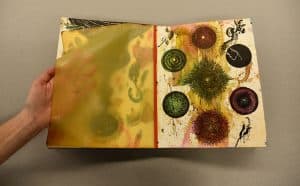 |
Drescher, Henrik. Too Much Bliss. New York: Granary Books, 1992. Printed by Phillip Gallo at The Hermetic Press. Binding by Daniel E. Kelm and staff at The Wide Awake Garage. Clamshell box by Jill Jevne. Edition of 41. [in the catalog]
The sixteen holes in this book’s front cover reveal a latex sheet, which is itself perforated to expose the printed and hand-colored pages that feature the almost shockingly vibrant images and words drawn and painted by the illustrator, painter, and animator Henrik Drescher, as well as “ornamentalities” contributed by Lauren Drescher. Kelm’s innovative wire-edge binding, which enables readers to examine every bit of each sheet, impacts readers’ experience in an particularly strong manner here. In this non-narrative book, the sight, feel, and smell of each sheet constitutes a compelling story. |
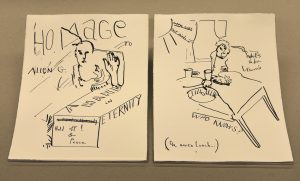 |
Waldman, Anne, and George Schneeman. Homage to Allen G. New York: Granary Books, 1997. Printed by Phillip Gallo. Boxes by Barbara Mauriello and Judith Ivry. Edition of 145. [in the catalog] Before Allen Ginsberg’s death in 1997, he and Schneeman had planned to complete a project using the poet’s photographs. Anne Waldman, Ginsberg’s longtime friend and associate, used his writings as a source for the words that populate Schneeman’s tracings of the photographs. |
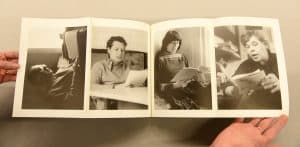 |
Rothenberg, Jerome, and David M. Guss, eds. The Book, Spiritual Instrument. New York: Granary Books, 1996. Designed by Diane Bertolo. Edition of 3000. [in the catalog] |
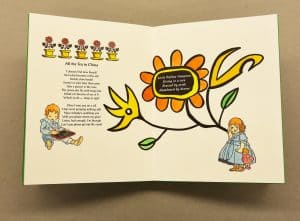 |
Bernstein, Charles, and Susan Bee. Little Orphan Anagram. New York: Granary Books, 1997. Printed by Joe Elliot at Soho Letterpress. Binding by Daniel E. Kelm and staff at The Wide Awake Garage. Edition of 35. [in the catalog] |
Credits
Exhibition Curation
Jennifer Buckley, Assistant Professor of English
Preparation & Installation
Giselle Simon, Conservator
Bill Voss, Exhibit Preparator
UI Libraries Conservation Lab
Design
Kalmia Strong, UI Libraries Creative Coordinator
Exhibit Coordination
Leah Morlan, Program Coordinator
Connor Hood, Public Engagement Specialist
UI Libraries Digital Scholarship & Publishing Studio
Website, Publicity & Other Assistance
Jennifer Masada, UI Libraries Strategic Communications Manager
Ken Clinkenbeard, UI Libraries Web Services Specialist
Financial Support for the Exhibition
Friends of the UI Libraries
Special Thanks
University of Iowa Center for the Book
University of Iowa English Department
Stephen Voyce, Associate Professor of English
Loren Glass, Professor of English
